Uzbekistan and Tajikistan Highlights
8 Days Private Tour of Tashkent - Bukhara - Samarkand - Seven Lakes - Panjakent - Istaravshan - Khujand - Tashkent
Tour Type: Private guided tour, flexible and customizable
Transportation: Air-conditioned private car with experienced driver
Hotels: 3- or 4-star well selected hotels, open to your choice
Meals: 7 breakfasts
Code: TCA103
Transportation: Air-conditioned private car with experienced driver
Hotels: 3- or 4-star well selected hotels, open to your choice
Meals: 7 breakfasts
Code: TCA103
This trip can be customized to meet your individual needs!
Free InquiryGet our reply within 24 hours!
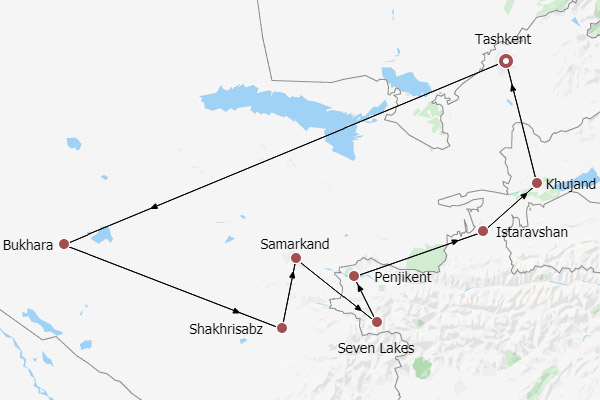
- Itinerary
- Reviews
Trip Highlights
- Admire mosques, madrasahs, mausoleums, and famous Trading Domes in Old Bukhara, an oasis city boasting a rich history.
- Get the skinny on Timur's unearthly curse in the magnificent noble tomb in Samarkand.
- Witness Tashkent's historical charm blending with modernity, and admire the exquisite Suzani embroidery.
- Trace the stories of the Sogdian traders in Khujand and Istaravshan, key cities along the ancient Silk Road.
- Hike around the Seven Lakes in the Fann Mountains and encounter the simple locals.
Expand All
Collapse All
Day 1 Arrival in Tashkent of Uzbekistan, Airport Pick-up, Tashkent City Tour
Welcome to Tashkent, the capital of Uzbekistan! Upon arrival at the airport, you'll be greeted by your private driver and escorted to the hotel. Perhaps Tashkent is a Central Asian city full of exoticism in your imagination; however, it features an accelerating modernization process, presenting a blend of historical charm and modernity, with buildings in Soviet and Islamic style coexisting side by side.
After a short rest, we’ll kick off the most classic route of Tashkent. First, admire the Khast-Imam Complex, the city’s influential Islamic cultural center, boasting several historical landmarks. You’ll be guided to the Madrasah of Barak-Khan, featuring classic blue domes, towering minarets, elaborately decorated walls with ceramic tiles, and gilded stone and wood carvings. Then, visit the Tilla Sheikh Mosque, which preserves one of the seven original manuscripts of the Quran, the sole fundamental scripture of Islam. And head to the Mausoleum of the Saint Abu Bakr Kaffal Shashi to pay homage to the outstanding jurist, linguist and poet, who is praised as "Hazrat Imam (the Great Imam)". The complex also includes one of Uzbekistan’s leading madrasahs, the Islamic Institute of Imam al-Bukhar, whose building itself is a masterpiece, with classic arches, tiled domes, and neatly trimmed gardens, exuding an air of serenity and solemnity.
Next, we’ll head to the renowned Chorsu Bazaar, a vibrant hub of the city's daily life. Under and outside the giant eye-catching turquoise dome, the stalls are piled high with an ocean of goods, including nuts, spices, pickles, fruit and dairy products. You might also have a chance to sample some delicacies like samosas (grilled buns) and mulberries, grapes, figs and pomegranates.
Afterward, head to the State Museum of Applied Art to admire Tajik handicrafts, including wood carvings, jewelry, wooden doors, and a large number of embroidery works of different eras, such as the unique gold Suzani embroidery. Generally used as bed covers, tapestries, and tablecloths, the decorative embroidery made from cotton or silk is traditionally part of a local girl’s dowry, prepared by her mother since birth.
Then, descend to the underground world to experience the Tashkent Metro, which was constructed in the Soviet era (1922-1991). Each of its four lines features a unique style, such as the Kosmonavtlar station in a space-themed design. Get off at Independence Square and visit the nearby Timur Square, which houses the statue of Amir Timur, the national hero who founded the powerful Timur Empire in the 14th century. Finally, round off today at the Earthquake Memorial and pay tribute to those who lost their lives in the catastrophic earthquake in 1966.
➤ For Your Information
1. Visa: Since the itinerary requires entering Uzbekistan twice, those who need a visa must obtain a double-entry visa in advance. Check if you qualify for visa-free entry; most visitors from the US and EU are not eligible.
2. Money: The som (UZS) is the official currency of Uzbekistan. Credit cards are accepted in large eateries and markets, but street stalls and small shops require payment in cash. You can exchange US dollars for Uzbek som at the exchange points in Chorsu Bazaar with good rates.
3. Necessities: It’s recommended that you prepare some toilet paper and hand sanitizer, as some bathrooms in Central Asian countries do not provide them.
Accommodation: Wyndham Tashkent (4 stars) or similar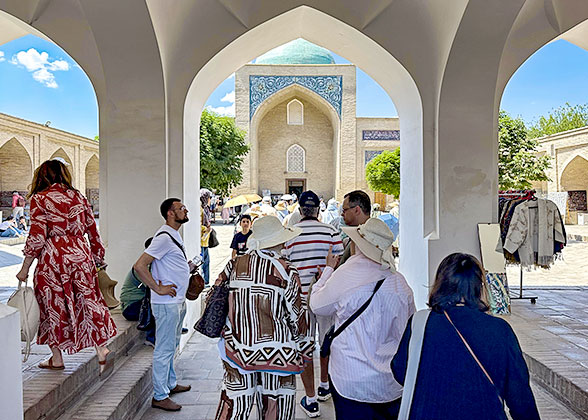
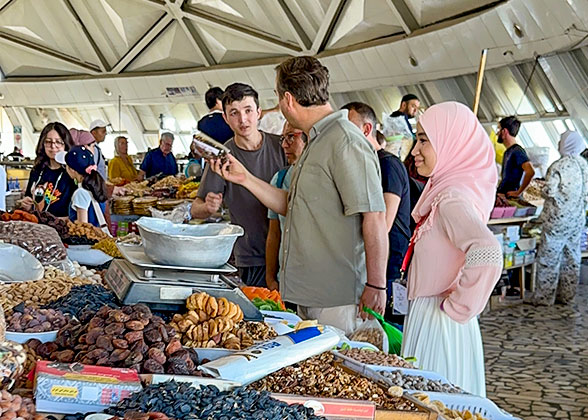
After a short rest, we’ll kick off the most classic route of Tashkent. First, admire the Khast-Imam Complex, the city’s influential Islamic cultural center, boasting several historical landmarks. You’ll be guided to the Madrasah of Barak-Khan, featuring classic blue domes, towering minarets, elaborately decorated walls with ceramic tiles, and gilded stone and wood carvings. Then, visit the Tilla Sheikh Mosque, which preserves one of the seven original manuscripts of the Quran, the sole fundamental scripture of Islam. And head to the Mausoleum of the Saint Abu Bakr Kaffal Shashi to pay homage to the outstanding jurist, linguist and poet, who is praised as "Hazrat Imam (the Great Imam)". The complex also includes one of Uzbekistan’s leading madrasahs, the Islamic Institute of Imam al-Bukhar, whose building itself is a masterpiece, with classic arches, tiled domes, and neatly trimmed gardens, exuding an air of serenity and solemnity.
Next, we’ll head to the renowned Chorsu Bazaar, a vibrant hub of the city's daily life. Under and outside the giant eye-catching turquoise dome, the stalls are piled high with an ocean of goods, including nuts, spices, pickles, fruit and dairy products. You might also have a chance to sample some delicacies like samosas (grilled buns) and mulberries, grapes, figs and pomegranates.
Afterward, head to the State Museum of Applied Art to admire Tajik handicrafts, including wood carvings, jewelry, wooden doors, and a large number of embroidery works of different eras, such as the unique gold Suzani embroidery. Generally used as bed covers, tapestries, and tablecloths, the decorative embroidery made from cotton or silk is traditionally part of a local girl’s dowry, prepared by her mother since birth.
Then, descend to the underground world to experience the Tashkent Metro, which was constructed in the Soviet era (1922-1991). Each of its four lines features a unique style, such as the Kosmonavtlar station in a space-themed design. Get off at Independence Square and visit the nearby Timur Square, which houses the statue of Amir Timur, the national hero who founded the powerful Timur Empire in the 14th century. Finally, round off today at the Earthquake Memorial and pay tribute to those who lost their lives in the catastrophic earthquake in 1966.
➤ For Your Information
1. Visa: Since the itinerary requires entering Uzbekistan twice, those who need a visa must obtain a double-entry visa in advance. Check if you qualify for visa-free entry; most visitors from the US and EU are not eligible.
2. Money: The som (UZS) is the official currency of Uzbekistan. Credit cards are accepted in large eateries and markets, but street stalls and small shops require payment in cash. You can exchange US dollars for Uzbek som at the exchange points in Chorsu Bazaar with good rates.
3. Necessities: It’s recommended that you prepare some toilet paper and hand sanitizer, as some bathrooms in Central Asian countries do not provide them.
Accommodation: Wyndham Tashkent (4 stars) or similar

Khast-Imam Complex, Tashkent

Chorsu Bazaar, Tahkent
Day 2 Train from Tashkent to Bukhara, Visit Kalyan Minaret and Iconic Mosques and Madrasahs
This morning, you’ll be escorted to catch the 4-hour high-speed train to Bukhara. Upon arrival, the local driver will pick you up and transfer you to the hotel. The peaceful and quaint city, located in the oasis of the Kyzylkum Desert, is dotted with buildings featuring yellowish walls and blue domes.
After checking in, your guide will accompany you to embark on an Old Bukhara walking tour. The first stop is the Lyabi Hauz Ensemble, where lies a pond that once was a part of the city's water supply system and now serves as a leisure gathering spot for locals and tourists, with the statue of humorous Nasreddin Hodja riding his donkey nearby. Then, pass by Magoki-Attori Mosque, Central Asia’s oldest mosque, and stroll through residential alleys to tick off Chor-Minor Madrasah, the principal subject on the cover of the Lonely Planet Central Asia guidebook. As the only surviving building of the madrasah, it features an exquisite scale and four compact, asymmetrical classic turquoise domes. Interestingly, birds once nested atop all the domes, and later during the restoration, the locals deliberately carved a bird's nest on one of the four.
We’ll also soak up the daily market vibe at Trading Domes, teeming with a profusion of handicrafts, including silk scarves, pottery jars, carpets, Persian miniatures and copperware, which makes you feel as if you’re trading on the ancient Silk Road thousands of years ago!
Afterward, visit Ulugbeg Madrasah, a model for architecture in many other Central Asian countries, and the Abdulaziz Khan Madrassah opposite, notable for its colorful glazed tiles, carved mosaics and stalactite vaults. Then, stand in awe of the 47-meter (154-foot) high Kalyan Minaret, the only structure that survived Genghis Khan’s invasion. It was once a lighthouse on the ancient Silk Road, illuminating the desert for the caravans. Connected to the minaret by a small bridge is the Kalyan Mosque, the principal mosque for Friday prayers. The Miri-Arab Madrasah, located opposite the mosque, has been dedicated to Islamic academic activities.
Our next stop is Ark Fortress, the oldest of its kind in Bukhara, built in the 5th century. It served as the residence of the once Bukhara rulers and is now a museum, displaying precious pages of the Quran, various handicrafts, ancient coins, and weapons. Afterward, admire the Bolo Khauz Mosque featuring beautifully carved wooden pillars, and the Samanid Mausoleum with unique brick roofs and walls displaying 22 different patterns, which was once disguised as a hill with mud to escape destruction during war. Today’s itinerary ends at Chashma Ayub Mausoleum, home to a water museum showcasing Bukhara’s water resource system. At last, return to the hotel.
Meal: Breakfast
Accommodation: Volida Hotel Bukhara (3 stars) or similar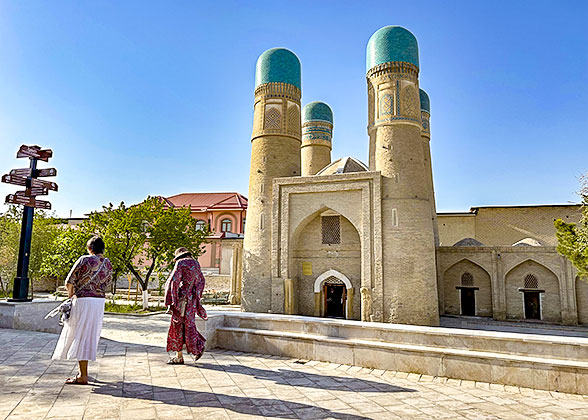
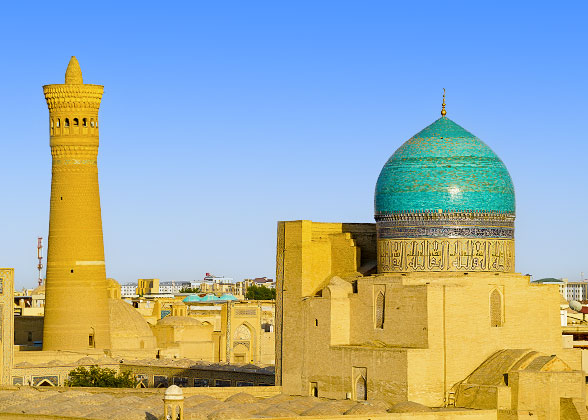
After checking in, your guide will accompany you to embark on an Old Bukhara walking tour. The first stop is the Lyabi Hauz Ensemble, where lies a pond that once was a part of the city's water supply system and now serves as a leisure gathering spot for locals and tourists, with the statue of humorous Nasreddin Hodja riding his donkey nearby. Then, pass by Magoki-Attori Mosque, Central Asia’s oldest mosque, and stroll through residential alleys to tick off Chor-Minor Madrasah, the principal subject on the cover of the Lonely Planet Central Asia guidebook. As the only surviving building of the madrasah, it features an exquisite scale and four compact, asymmetrical classic turquoise domes. Interestingly, birds once nested atop all the domes, and later during the restoration, the locals deliberately carved a bird's nest on one of the four.
We’ll also soak up the daily market vibe at Trading Domes, teeming with a profusion of handicrafts, including silk scarves, pottery jars, carpets, Persian miniatures and copperware, which makes you feel as if you’re trading on the ancient Silk Road thousands of years ago!
Afterward, visit Ulugbeg Madrasah, a model for architecture in many other Central Asian countries, and the Abdulaziz Khan Madrassah opposite, notable for its colorful glazed tiles, carved mosaics and stalactite vaults. Then, stand in awe of the 47-meter (154-foot) high Kalyan Minaret, the only structure that survived Genghis Khan’s invasion. It was once a lighthouse on the ancient Silk Road, illuminating the desert for the caravans. Connected to the minaret by a small bridge is the Kalyan Mosque, the principal mosque for Friday prayers. The Miri-Arab Madrasah, located opposite the mosque, has been dedicated to Islamic academic activities.
Our next stop is Ark Fortress, the oldest of its kind in Bukhara, built in the 5th century. It served as the residence of the once Bukhara rulers and is now a museum, displaying precious pages of the Quran, various handicrafts, ancient coins, and weapons. Afterward, admire the Bolo Khauz Mosque featuring beautifully carved wooden pillars, and the Samanid Mausoleum with unique brick roofs and walls displaying 22 different patterns, which was once disguised as a hill with mud to escape destruction during war. Today’s itinerary ends at Chashma Ayub Mausoleum, home to a water museum showcasing Bukhara’s water resource system. At last, return to the hotel.
Meal: Breakfast
Accommodation: Volida Hotel Bukhara (3 stars) or similar

Chor-Minor Madrasah, Bukhara

Kalyan Minaret, Bukhara
Day 3 Bukhara: Summer Palace & Iconic Mausoleums; High-speed Train to Samarkand
We’ll devote the whole morning to continuing Bukhara's exploration. First, admire the Summer Palace, aka Sitorai Mohi Hosa, whose majestic gateway is adorned with rose-red, green and blue tiles. Wander through the eye-catching turquoise corridor and the pond in the courtyard, and marvel at the magnificent interior architecture, whose colorful glazed tiles, arched porticos and ornate chandeliers all showcase a blend of European and local styles. Legend has it that the king was troubled by the siting of the palace. One day, he ordered that a piece of mutton be hung in the four directions of the city. After some time, only the meat in the north remained fresh. Thus, he made up his mind.
Then, drop by the Memorial Complex of Bahouddin Naqshband, which was built to revere one of Islam’s most venerated saints. The white marble tomb is located in the center, surrounded by mosques, a small madrasah, and tombs of Bukhara nobles who desired to be buried beside the saint. We’ll also head to the western suburbs to visit the UNESCO-listed Chor-Bakr Necropolis, a mausoleum complex mainly for Prophet Muhammad’s descendants.
In the afternoon, you’ll be transferred to the train station to catch the 2-hour high-speed train to Samarkand. Upon arrival, you’ll be escorted to the hotel by your private local driver. Nestled in the broad and fertile Zarafshan Valley, Samarkand was once a crossroad of the world, especially during the Timurid Dynasty (1370-1499), when Timur recruited many talented craftsmen from Persia, India, and Arabia, leading to a rapid development.
➤ Recommended Snack in Samarkand (at your own expense)
Somsas are a highlight of Central Asian cuisine. The grilled buns are filled with seasoned beef or lamb, and vegetables. The freshly baked somsas have a rich scent and crispy crusts. Take a bite and it’ll be a flavor explosion in your mouth! You can try some at Alibek Somsa Restaurant, which is patronized by locals, at a cost of around UZS 10,000 (USD 0.7) per serving. Besides, it’s a bonus to watch how somsas are neatly slapped on the inside wall of the clay oven!
Address: JXG4+5PJ, Mironshokh Mirzo Str, Samarkand
Meal: Breakfast
Accommodation: Grand Samarkand Superior (4 stars) or similar
Then, drop by the Memorial Complex of Bahouddin Naqshband, which was built to revere one of Islam’s most venerated saints. The white marble tomb is located in the center, surrounded by mosques, a small madrasah, and tombs of Bukhara nobles who desired to be buried beside the saint. We’ll also head to the western suburbs to visit the UNESCO-listed Chor-Bakr Necropolis, a mausoleum complex mainly for Prophet Muhammad’s descendants.
In the afternoon, you’ll be transferred to the train station to catch the 2-hour high-speed train to Samarkand. Upon arrival, you’ll be escorted to the hotel by your private local driver. Nestled in the broad and fertile Zarafshan Valley, Samarkand was once a crossroad of the world, especially during the Timurid Dynasty (1370-1499), when Timur recruited many talented craftsmen from Persia, India, and Arabia, leading to a rapid development.
➤ Recommended Snack in Samarkand (at your own expense)
Somsas are a highlight of Central Asian cuisine. The grilled buns are filled with seasoned beef or lamb, and vegetables. The freshly baked somsas have a rich scent and crispy crusts. Take a bite and it’ll be a flavor explosion in your mouth! You can try some at Alibek Somsa Restaurant, which is patronized by locals, at a cost of around UZS 10,000 (USD 0.7) per serving. Besides, it’s a bonus to watch how somsas are neatly slapped on the inside wall of the clay oven!
Address: JXG4+5PJ, Mironshokh Mirzo Str, Samarkand
Meal: Breakfast
Accommodation: Grand Samarkand Superior (4 stars) or similar
Day 4 Samarkand: Registan Square, Siyob Bazaar, Bibi Khanym Mosque & Gur-Emir Mausoleum
Accompanied by the guide and the driver, today's itinerary will start from the most famous Registan Square, which boasts three magnificent madrasahs: the Ulugbeg madrasah, named after Timur's grandson; the Sher Dor madrasah, with its portico featuring vivid lion-tiger mosaics; and the gilded Tilla Kari madrasah. A magnificent light show on the square beckons visitors around 21:00, and you can enjoy it on your own if you wish.
Afterward, experience the vibrant atmosphere of indigenous market culture in the Siyob Bazaar, with a dazzling array of goods, including vegetables, and dried fruits such as almonds, figs, and raisins, as well as various souvenirs like ethnic clothing, hats and silk. You might be confused to see baskets of stones at stalls, which are actually mineral salts used as medicines by locals. Then, visit the nearby Bibi Khanym Mosque, built by Timur for his beloved wife, which is considered one of the most magnificent Eastern buildings during the Timurid era! Marvel at its grand entrance, eye-catching blue domes and exquisite floral carvings. We’ll also catch a glimpse of the Ulugbek Observatory, one of the most influential observatories in the Middle Ages (5th-15th CE). It boasts a small museum displaying ancient astronomical instruments, manuscripts and models, showing the astronomical contributions of the farsighted ruler.
Continue our trip to Shakhi-Zinda Necropolis, the resting place of Timurid female nobles and Qusam ibn-Abbas, a cousin of Muhammad, who brought Islam here in the 7th century. Take your time appreciating the stunning building, and the murals, pottery with geometric and floral patterns, and the honeycomb-shaped dome with gold and cobalt blue decorations will leave you awestruck. Finally, round off today at the Gur-Emir Mausoleum, where Timur and his descendants rest in peace. Be smitten by the lavishly decorated tomb with ribbed turquoise dome, onyx walls, and ceilings carved with gilded reliefs. It is said that a curse of Timur lingers around the tomb. Once, a Persian monarch took a piece of jade from Timur’s sarcophagus, and as a result, his son fell ill suddenly and mysteriously. Only after the monarch returned the jade did his son recover.
Meal: Breakfast
Accommodation: Grand Samarkand Superior (4 stars) or similar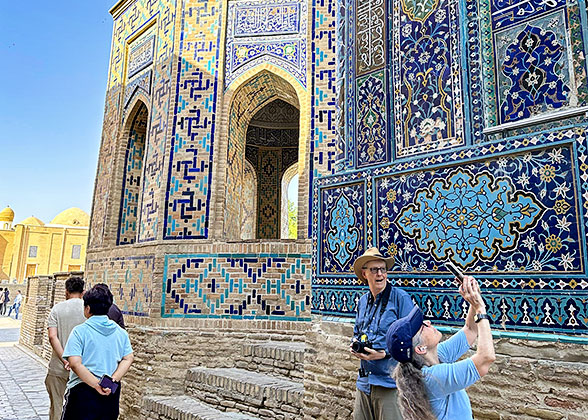
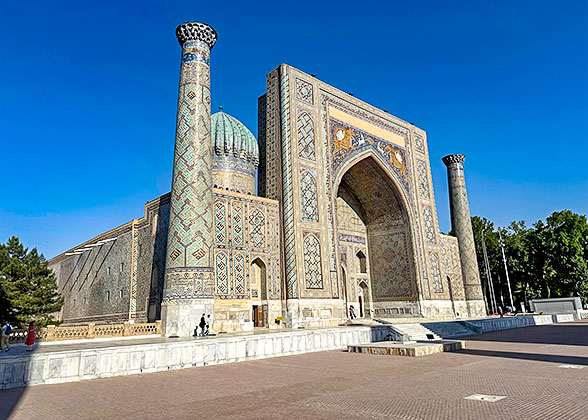
Afterward, experience the vibrant atmosphere of indigenous market culture in the Siyob Bazaar, with a dazzling array of goods, including vegetables, and dried fruits such as almonds, figs, and raisins, as well as various souvenirs like ethnic clothing, hats and silk. You might be confused to see baskets of stones at stalls, which are actually mineral salts used as medicines by locals. Then, visit the nearby Bibi Khanym Mosque, built by Timur for his beloved wife, which is considered one of the most magnificent Eastern buildings during the Timurid era! Marvel at its grand entrance, eye-catching blue domes and exquisite floral carvings. We’ll also catch a glimpse of the Ulugbek Observatory, one of the most influential observatories in the Middle Ages (5th-15th CE). It boasts a small museum displaying ancient astronomical instruments, manuscripts and models, showing the astronomical contributions of the farsighted ruler.
Continue our trip to Shakhi-Zinda Necropolis, the resting place of Timurid female nobles and Qusam ibn-Abbas, a cousin of Muhammad, who brought Islam here in the 7th century. Take your time appreciating the stunning building, and the murals, pottery with geometric and floral patterns, and the honeycomb-shaped dome with gold and cobalt blue decorations will leave you awestruck. Finally, round off today at the Gur-Emir Mausoleum, where Timur and his descendants rest in peace. Be smitten by the lavishly decorated tomb with ribbed turquoise dome, onyx walls, and ceilings carved with gilded reliefs. It is said that a curse of Timur lingers around the tomb. Once, a Persian monarch took a piece of jade from Timur’s sarcophagus, and as a result, his son fell ill suddenly and mysteriously. Only after the monarch returned the jade did his son recover.
Meal: Breakfast
Accommodation: Grand Samarkand Superior (4 stars) or similar

Shakhi-Zinda Necropolis, Samarkand

Gur-Emir Mausoleum, Samarkand
Day 5 Transfer to Panjakent of Tajikistan; Enjoy Scenic Hikes around Seven Lakes
After breakfast, say farewell to Samarkand and leave for Panjakent, Tajikistan, via the Jartepa border. After crossing the border, meet your Panjakent guide and the driver, who will escort you to the Seven Lakes, locally known as Haft Kul, a chain of alpine lakes in the narrow gorge of the Fann Mountains and fed by the melting glacier. The lakes vary in size and color from turquoise to deep blue and green, with altitudes rising from 1,640 meters (5,380 feet) to 2,400 meters (7,874 feet). As the mountain roads are dusty, winding, and bumpy, it’s advisable to wear a breathable dust mask and pack your neck pillow and waist pad to make the tour easier.
Upon arriving at the fourth lake, alight from the car and enjoy a 1.5-hour hike. Immerse yourself in the breathtaking views of the elongated emerald water, the natural green carpet adorned with colorful wildflowers, the layered mountains meeting the blue sky and white clouds, and winding mud roads and streams through the mountains. Then, continue driving to the sixth lake and take another hike to the seventh lake. Along the way, climb up a small hill, and slow down your pace to admire a bird’s-eye view of the valley. You may also see villagers lead donkeys fully loaded with daily supplies, women wash clothes by the river, herders graze sheep or cattle leisurely, and children from nearby villages proudly show you their precious red stones. Finally, we’ll drive back to Panjakent.
➤ Useful Info for Tajikistan
1. After entering Tajikistan, the altitude gradually increases and the temperature drops, so please pack a coat and some cold medicines for emergencies.
2. Somoni is the official currency of Tajikistan. Since cash is widely used, you can exchange some somonis at the exchange point at the Jartepa border.
Meal: Breakfast
Accommodation: Panjakent Plaza Hotel (3 stars) or similar
Upon arriving at the fourth lake, alight from the car and enjoy a 1.5-hour hike. Immerse yourself in the breathtaking views of the elongated emerald water, the natural green carpet adorned with colorful wildflowers, the layered mountains meeting the blue sky and white clouds, and winding mud roads and streams through the mountains. Then, continue driving to the sixth lake and take another hike to the seventh lake. Along the way, climb up a small hill, and slow down your pace to admire a bird’s-eye view of the valley. You may also see villagers lead donkeys fully loaded with daily supplies, women wash clothes by the river, herders graze sheep or cattle leisurely, and children from nearby villages proudly show you their precious red stones. Finally, we’ll drive back to Panjakent.
➤ Useful Info for Tajikistan
1. After entering Tajikistan, the altitude gradually increases and the temperature drops, so please pack a coat and some cold medicines for emergencies.
2. Somoni is the official currency of Tajikistan. Since cash is widely used, you can exchange some somonis at the exchange point at the Jartepa border.
Meal: Breakfast
Accommodation: Panjakent Plaza Hotel (3 stars) or similar
Day 6 Panjakent City Tour - Drive 4 Hours to Istaravshan - Transfer to Khujand
Today, the Sogdian hub Panjakent, ‘the city of merchants’ along the ancient Silk Road awaits your exploration. We’ll visit the Republican Museum of History and Local Lore of Rudaki, which focuses on the region’s history and reveres Rudaki, the father of Persian literature, displaying abundant precious artifacts, including ethnic costumes, traditional jewelry, ancient coins, and pottery. The typical eye-opener is the colorful Sogdian murals, which vividly depict the religious rituals, epics, battle scenes, noble hunting and folk customs. After that, experience Panjakent’s bustling atmosphere at the Central Market Bazaar, a compact market covering all the daily stuff like spices, vegetables, fresh and dried fruits, and clothing. Afterward, pay homage to the father of Persian poetry at the hillside Rudaki Mausoleum, whose turquoise dome is eye-catching among the vegetation and mountains. It nestles 60 kilometers (37 miles) east of the city, remote but said to be his birthplace.
We’ll drive past Shahriston Pass at an altitude of 3,378 meters (11,083 feet), through a 5-kilometer (3-mile) long dim tunnel, to cross the summit of the M43 highway, and arrive at Istaravshan, which has survived for over 2,500 years and presents a combination of Greek and Persian cultures, as it was once conquered by Alexander the Great. We’ll explore the Fortress Mug Teppe, an ancient citadel featuring a magnificent blue-domed brick gate and walls with Persian-era reliefs. Ascend the fortress and enjoy a panoramic view of the entire city. Then, pass through the labyrinthine alleys to admire the Kuk Gumbaz Mosque, a small Timurid madrasah built in the 16th century. Afterward, stroll around the bazaar in Istaravshan, especially famous for folk handicrafts, among which handmade knives are highly prized. Take your time browsing the exquisite handicrafts and exchanging warm greetings with the friendly vendors.
After the visit, we’ll drive to Khujand, the second largest city in Tajikistan and a vital settlement along the ancient Silk Road. Upon arrival, check into the hotel, and the rest of the day is on your own.
➤ Dinner Recommendation at Khujand (at your own expense)
The "Zaytun" Restaurant features a typical Tajik twist, providing traditional dining tables where you can sit cross-legged. If you prefer outdoor dining, there are also terrace tables offering a beautiful city view. The signature dishes include lamb chops, grilled skewers, and beef pilaf. It’s open until 23:00 and accepts credit cards. Additionally, it offers delivery service.
Average Cost per Person: TJS 50-100 (USD 5-10)
Address: Sir-darya Street, Khujand
Meal: Breakfast
Accommodation: Parliament Hotel Khujand (4 stars) or similar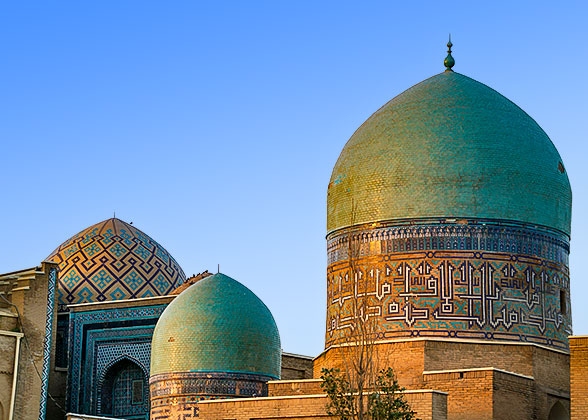
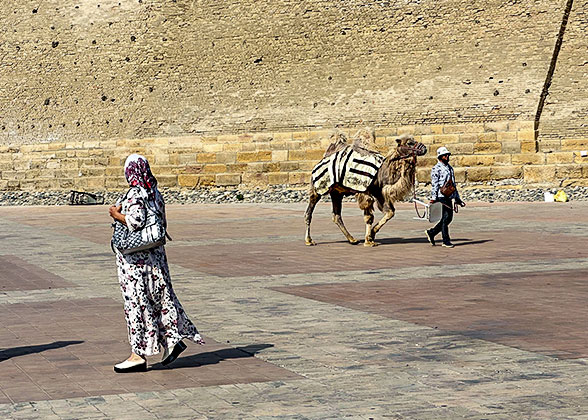
We’ll drive past Shahriston Pass at an altitude of 3,378 meters (11,083 feet), through a 5-kilometer (3-mile) long dim tunnel, to cross the summit of the M43 highway, and arrive at Istaravshan, which has survived for over 2,500 years and presents a combination of Greek and Persian cultures, as it was once conquered by Alexander the Great. We’ll explore the Fortress Mug Teppe, an ancient citadel featuring a magnificent blue-domed brick gate and walls with Persian-era reliefs. Ascend the fortress and enjoy a panoramic view of the entire city. Then, pass through the labyrinthine alleys to admire the Kuk Gumbaz Mosque, a small Timurid madrasah built in the 16th century. Afterward, stroll around the bazaar in Istaravshan, especially famous for folk handicrafts, among which handmade knives are highly prized. Take your time browsing the exquisite handicrafts and exchanging warm greetings with the friendly vendors.
After the visit, we’ll drive to Khujand, the second largest city in Tajikistan and a vital settlement along the ancient Silk Road. Upon arrival, check into the hotel, and the rest of the day is on your own.
➤ Dinner Recommendation at Khujand (at your own expense)
The "Zaytun" Restaurant features a typical Tajik twist, providing traditional dining tables where you can sit cross-legged. If you prefer outdoor dining, there are also terrace tables offering a beautiful city view. The signature dishes include lamb chops, grilled skewers, and beef pilaf. It’s open until 23:00 and accepts credit cards. Additionally, it offers delivery service.
Average Cost per Person: TJS 50-100 (USD 5-10)
Address: Sir-darya Street, Khujand
Meal: Breakfast
Accommodation: Parliament Hotel Khujand (4 stars) or similar

Dome of Kuk Gumbaz Mosque

Local People in Tajikistan
Day 7 Khujand: Historical Local Lore Museum, Panjshanbe Market, and Arbob Cultural Palace
Today, we’ll mainly dive into Khujand, where the Syr Darya River winds through, fed by the melted snow of the Heavenly Mountains. First, visit the Historical Local Lore Museum of Archeology and Fortification, also known as the Sughd Region Museum, which resembles a medieval fortress in appearance. After viewing the sculpture of the national hero Timur in the entrance hall, learn about the thousands of years of history of the Sogdians in northern Tajikistan from a wealth of artifacts, including pottery, ethnic textiles, and sculptures. Khujand was once a settlement of the Sogdians, an ancient Central Asian ethnic group skilled in business, who traded with Chinese, Indians, Persians, and Mongolians from the 3rd to 8th centuries. Most Sogdians followed Zoroastrianism, believing that fire represents truth and wisdom and must not be defiled, so that they would practice excarnation rather than cremation, leaving the dead to be eaten by birds. In the museum, you can find their ossuary, a pottery container used to store the bones of the deceased after being defleshed. The museum also displays astonishing mosaics depicting Alexander the Great's legendary life.
Then, head to Panjshanbe Square in the city center to admire the Mausoleum of Sheik Muslekheddin, the ruler of the 12th century. The complex additionally boasts a 19th-century minaret and a blue-domed mosque. Opposite the solemn site is the vibrant Panjshanbe Market. In the past, Central Asian markets were held separately on a certain day of the week, and the comprehensive Panjshanbe Market was the famous Thursday market with a huge space that is somewhat unexpected in this small town. Under the large Soviet-style hall, you can find almost all daily necessities like fruits, handicrafts, and imported goods.
Khujand experienced tumultuous changes of several empires, leaving behind the diverse ethnic groups, including Uzbeks, Kyrgyzs and Russians, and architecture of mixed styles. The Arbob Cultural Palace, the former headquarters of Soviet collective farms, serves as an example. Round off today at the Qairoqum Reservoir, known locally as the Tajik Sea, a popular spot for fishing, swimming and sunbathing. Seafood restaurants line the lake, and since you’ve had pilaf and naan bread several days, it’ll be a refreshing choice to sample some grilled fish by yourself.
Meal: Breakfast
Accommodation: Parliament Hotel Khujand (4 stars) or similar
Then, head to Panjshanbe Square in the city center to admire the Mausoleum of Sheik Muslekheddin, the ruler of the 12th century. The complex additionally boasts a 19th-century minaret and a blue-domed mosque. Opposite the solemn site is the vibrant Panjshanbe Market. In the past, Central Asian markets were held separately on a certain day of the week, and the comprehensive Panjshanbe Market was the famous Thursday market with a huge space that is somewhat unexpected in this small town. Under the large Soviet-style hall, you can find almost all daily necessities like fruits, handicrafts, and imported goods.
Khujand experienced tumultuous changes of several empires, leaving behind the diverse ethnic groups, including Uzbeks, Kyrgyzs and Russians, and architecture of mixed styles. The Arbob Cultural Palace, the former headquarters of Soviet collective farms, serves as an example. Round off today at the Qairoqum Reservoir, known locally as the Tajik Sea, a popular spot for fishing, swimming and sunbathing. Seafood restaurants line the lake, and since you’ve had pilaf and naan bread several days, it’ll be a refreshing choice to sample some grilled fish by yourself.
Meal: Breakfast
Accommodation: Parliament Hotel Khujand (4 stars) or similar
Day 8 Drive back to Tashkent of Uzbekistan, Airport See-off
Today, your Uzbekistan and Tajikistan tours come to an end, and you’ll be transferred to the border of Uzbekistan, where the local driver will be waiting for you and escort you to Tashkent Airport for your flight home. Have a nice trip!
If you would like to explore more, such as the well-preserved ancient Khiva in Uzbekistan, the capital Dushanbe and the legendary Pamir Mountains in Tajikistan, the amazing natural Darvaza Gas Crater (Gate of Hell) in Turkmenistan, and the magnificent Charyn Canyon in Kazakhstan, please feel free to contact us at any time. We’ll tailor the best itinerary for you!
Meal: Breakfast
If you would like to explore more, such as the well-preserved ancient Khiva in Uzbekistan, the capital Dushanbe and the legendary Pamir Mountains in Tajikistan, the amazing natural Darvaza Gas Crater (Gate of Hell) in Turkmenistan, and the magnificent Charyn Canyon in Kazakhstan, please feel free to contact us at any time. We’ll tailor the best itinerary for you!
Meal: Breakfast
Expand All
Collapse All
This trip can be customized to meet your individual needs!
Itineraries you may also like:
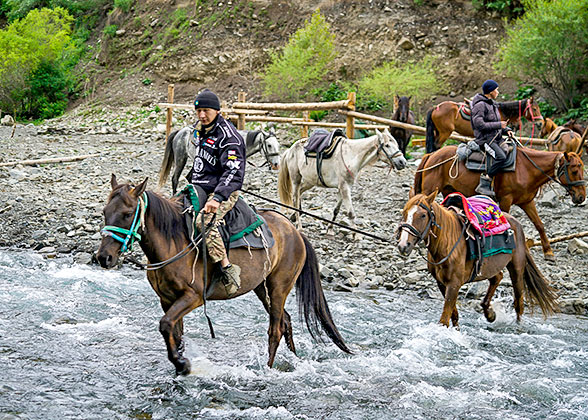 11 Days Dushanbe - Kalai-Khumb - Khorog - Ishkashim - Yamg - Langar - Murghab - Khorog - Kalai - Khumb - Dushanbe from USD2040
11 Days Dushanbe - Kalai-Khumb - Khorog - Ishkashim - Yamg - Langar - Murghab - Khorog - Kalai - Khumb - Dushanbe from USD2040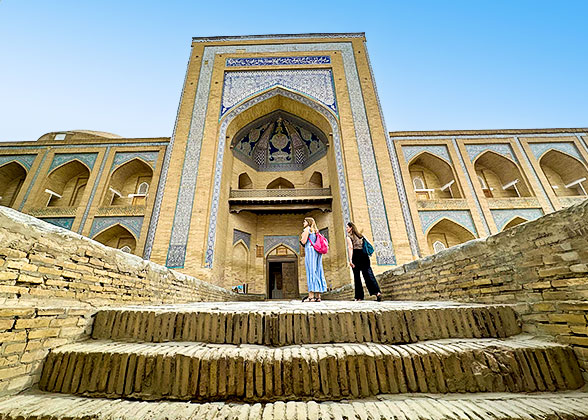 16 Days Tashkent - Nukus - Muynak - Kunya Urgench - Darvaza - Khiva - Bukhara - Samarkand - Panjakent - Khujand - Fergana - Osh - Chon Kemin - Bishkek
16 Days Tashkent - Nukus - Muynak - Kunya Urgench - Darvaza - Khiva - Bukhara - Samarkand - Panjakent - Khujand - Fergana - Osh - Chon Kemin - Bishkek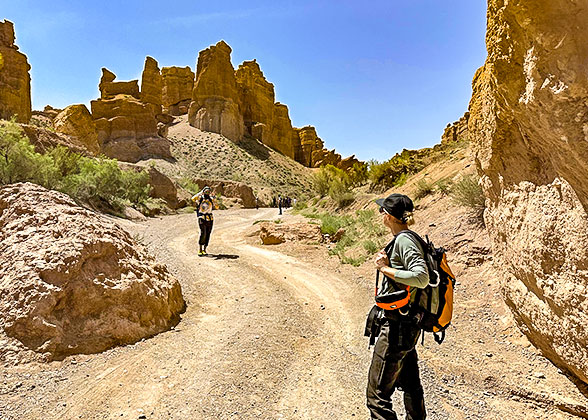 17 Days Tashkent - Khiva - Bukhara - Samarkand - Tashkent - Kokand - Fergana - Osh - Bishkek - Cholpon Ata - Karakol - Saty - Charyn Canyon - Almaty
17 Days Tashkent - Khiva - Bukhara - Samarkand - Tashkent - Kokand - Fergana - Osh - Bishkek - Cholpon Ata - Karakol - Saty - Charyn Canyon - Almaty
